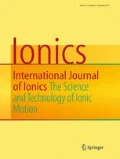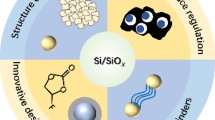Abstract
Lithium exchange mechanism, local structure, and its possible evolutions on lithium ion extraction and reinsertion are studied in Si-O-C materials. As the silicon distributions and microstructure change with the synthetic method, the relationship between the capacity and silicon structures is evaluated. By comparing derivative capacity curves of the ordinary anode materials composed of Si, C, or O, silicon species in terms of SiOnC4-n (1 ≤ n ≤ 4) are deduced to be the main source of lithium storage in Si-O-C materials. Of all the silicon species, SiOnC4-n (2 ≤ n ≤ 4) are confirmed to be reversible with lithium, but SiOC3 species be irreversible, by tracing the silicon structural changes during lithium insertion/distraction utilizing 29Si MAS NMR. Galvanostatic tests show the reversible capacity increases with the increase of the sum of SiOnC4-n (2 ≤ n ≤ 4) and decreases with the increase of SiOC3 content. Furthermore, a model is established to express the relationship between the capacity and silicon species. According to the model, 1 mol of SiO4, SiO3C, SiO2C2, or SiOC3 species can reversible deliver 3.0, 2.5, 0.5, or 0 mol of lithium ions, respectively. Applied to the reported data, the predictive capacities following the model agree well with the experimental values.







Similar content being viewed by others
References
Wilson AM, Reimers JN, Fuller EW, Dahn JR (1994) Lithium insertion in pyrolyzed siloxane polymers. Solid State Ionics 74:249–254
Wilson AM, Xing W, Zank G, Yates B, Dahn JR (1997) Pyrolysed pitch-polysilane blends for use as anode materials in lithium ion batteries II: the effect of oxygen. Solid State Ionics 100:259–266
Wilson AM, Zank G, Eguchi K, Xing W, Dahn JR (1997) Pyrolysed silicon-containing polymers as high capacity anodes for lithium-ion batteries. J Power Sources 68:195–200
Wilson AM, Zank G, Eguchi K, Xing W, Yates B, Dahn JR (1997) Polysiloxane Pyrolysis. Chem Mater 9:1601–1606
Ning L, Wu Y, Wang L, Fang S, Holze R (2005) Carbon anode materials from polysiloxanes for lithium ion batteries. J Solid State Electrochem 9:520–523
Fukui H, Ohsuka H, Hino T, Kanamura K (2010) A Si−O−C composite anode: high capability and proposed mechanism of lithium storage associated with microstructural characteristics. ACS Appl Mater Interfaces 2:998–1008
Liu X, Zheng M-C, Xie K (2011) Mechanism of lithium storage in Si–O–C composite anodes. J. Power Sources 196:10667–10672
Xing W, Wilson AM, Eguchi K, Zank G, Dahn JR (1997) Pyrolyzed polysiloxanes for use as anode materials in lithium-ion batteries. J Electrochem Soc 144:2410
Konno H, Morishita T, Wan C, Kasashima T, Habazaki H, Inagaki M (2007) Si–C–O glass-like compound/exfoliated graphite composites for negative electrode of lithium ion battery. Carbon 45:477–483
Shen J, Raj R (2011) Silicon-oxycarbide based thin film anodes for lithium ion batteries. J Power Sources 196:5945–5950
Shen J, Ahn D, Raj R (2011) C-rate performance of silicon oxycarbide anodes for Li+ batteries enhanced by carbon nanotubes. J Power Sources 196:2875–2878
Liu X, Xie K, Zheng C-M, Wang J, Jing Z (2012) Si–O–C materials prepared with a sol–gel method for negative electrode of lithium battery. J Power Sources 214:119–123
Liu X, Xie K, Wang J, Zheng C (2012) Si/Si–O–C composite anode materials exhibiting good C rate performances prepared by a sol–gel method. J Mater Chem 22(37):19621
Boukamp BA, Lesh GC, Huggins RA (1981) All-Solid Lithium Electrodes with Mixed-Conductor Matrix. J Electrochem Soc 128:725
Sharma RA, Seefurth RN (1976) Thermodynamic Properties of the Lithium-Silicon System. J Electrochem Soc 123:1763
Marel CVD, Vinke GJB, Lugt WVD (1985) The phase diagram of the system lithium-silicon. Solid State Commun 54:917–919
Sato K, Noguchi M, Demachi A, Oki N, Endo M (1994) A mechanism of lithium storage in disordered carbons. Science 264:556–558
Dahn JR, Zheng T, Liu Y, Xue JS (1995) Mechanisms for Lithium Insertion in Carbonaceous Materials. Science 270:590–593
Sun Q, Zhang B, Fu Z-W (2008) Lithium electrochemistry of SiO2 thin film electrode for lithium-ion batteries. Appl Surf Sci 254:3774–3779
Miyachi M, Yamamoto H, Kawai H, Ohta T, Shirakata M (2005) Analysis of SiO anodes for lithium-ion batteries. J Electrochem Soc 152:A2089
Saha A, Rajw R, Williamson DL (2006) A model for the nanodomains in polymer-derived silicon oxycarbide. J Am Ceram Soc 89:2188
Gong J, Wu H (2000) Electrochemical intercalation of lithium species into disordered carbon prepared by the heat-treatment of poly (p-phenylene) at 650°C for anode in lithium-ion battery. Electrochim Acta 45:1753–1762
Kim H, Cho J (2008) Superior Lithium Electroactive Mesoporous Si@Carbon Core−Shell Nanowires for Lithium Battery Anode Material. Nano Lett 8:3688–3691
Baranchugov V, Markevich E, Pollak E, Salitra G, Aurbach D (2007) Amorphous silicon thin films as a high capacity anodes for Li-ion batteries in ionic liquid electrolytes. Electrochem Commun 9:796–800
Yang J, Takeda Y, Imanishi N, Capiglia C, Xie J, Yamamoto O (2002) SiOx-based anodes for secondary lithium batteries. Solid State Ionics 152:125
Nagao Y, Sakaguchi H, Honda H, Fukunaga T, Esaka T (2004) Structural analysis of pure and electrochemically lithiated SiO using neutron elastic scattering. J Electrochem Soc 151:A1572
Sorarh GD, Andrea GD, Glisenti A (1996) XPS characterization of gel-derived silicon oxycarbide glasses. Mater Lett 27:1–5
Pantano CG, Singh AK, Zhang H, Sol-Gel J (1999) Silicon oxycarbide glasses. Sci Technol 14:7
Yata S, Kinoshita H, Komori M, Ando N, Kashiwamura T, Harada T, Tanaka K, Yamabe T (1994) Structure and properties of deeply Li-doped polyacenic semiconductor materials beyond C6Li stage. Synth Met 62:153–158
Zheng T, Zhong Q, Dahn JR (1995) High-Capacity Carbons Prepared from Phenolic Resin for Anodes of Lithium-Ion Batteries. J Electrochem Soc 142:L211
Zheng T, Liu Y, Fuller EW, Tseng S, Sacken UV, Dahn JR (1995) Lithium Insertion in High Capacity Carbonaceous Materials. J Electrochem Soc 142:2581
Sanchez-Jimenez PE, Raj R (2010) Lithium insertion in polymer-derived silicon oxycarbide ceramics. J Amer Chem Soc 93:1127
Soraru GD, D'Andrea G, Campostrini R, Babonneau F, Mariotto G (1995) Structural characterization and high-temperature behavior of silicon oxycarbide glasses prepared from sol-gel precursors containing Si-H bonds. J Am Ceram Soc 78:379–387
Funding
The authors were financially supported by the National Science Foundation of China (51902343), Hunan Provincial Natural Science Foundation of China (2018JJ3595), and the Opening Project of State Key Laboratory of Advanced Chemical Power Sources (No. SKL-ACPS C16).
Author information
Authors and Affiliations
Corresponding authors
Ethics declarations
Conflict of interest
The authors declare that they have no competing interests.
Additional information
Publisher’s note
Springer Nature remains neutral with regard to jurisdictional claims in published maps and institutional affiliations.
Electronic supplementary material
ESM 1
(PDF 624 kb).
Rights and permissions
About this article
Cite this article
Zheng, C., Liu, X., Xie, K. et al. Study on lithium storage in silicon species of Si-O-C materials. Ionics 26, 3853–3862 (2020). https://doi.org/10.1007/s11581-020-03555-z
Received:
Revised:
Accepted:
Published:
Issue Date:
DOI: https://doi.org/10.1007/s11581-020-03555-z




